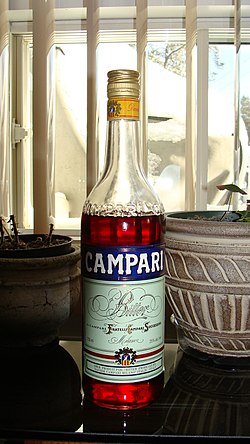Campari
This article needs additional citations for verification. (May 2009) |

Campari is an alcoholic apéritif (20.5%, 21%, 25% or 28% ABV, depending on the country in which it is sold) obtained from the infusion of herbs and fruit (including chinotto) in alcohol and water. It is a bitters characterized by its dark red color.
Campari is often used in cocktails and is commonly served with soda water, wine, or citrus juice. It is produced by the Campari Group, a multi-national company based in Italy.
History
The history of Campari began in 1860 with its invention by Gaspare Campari in Novara, Italy. The original recipe still in use today is kept confidential. According to Gruppo Campari, only one person in the world knows the entire formula.[citation needed] It was originally colored with carmine dye, derived from crushed cochineal insects, which gave the drink its distinctive red color.
In 1904, Campari's first production plant was opened in Sesto San Giovanni, near Milan, Italy. The company required bars that bought Campari to display the Campari Bitters sign. Under the direction of Davide Campari, Gaspare's son, the company began to export the beverage, first to Nice in the heart of the French Riviera, then overseas. The Campari brand is now distributed in over 190 countries.
In the Italian market, Campari mixed with soda water is sold in individual bottles as Campari Soda (10% alcohol by volume). Campari Soda is packaged in a distinctive bottle that was designed by Fortunato Depero in 1932. Campari is said to have been the inspiration for other bitter sweet drinks such as Kinnie, produced in Malta since 1952.
Campari is an essential ingredient in the classic Negroni cocktail, the Garibaldi cocktail, and in the Americano, which was named at a time when few Americans were aware of Campari. Campari also can be used to make a sorbet.
